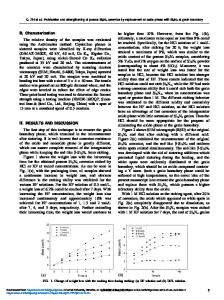Fabrication and flexural strength of porous Si 3 N 4 ceramics with Li 2 CO 3 and Y 2 O 3 as sintering additives
- PDF / 1,881,400 Bytes
- 9 Pages / 595.22 x 842 pts (A4) Page_size
- 33 Downloads / 308 Views
Fabrication and flexural strength of porous Si3N4 ceramics with Li2CO3 and Y2O3 as sintering additives HU Hai-long(胡海龙)1, 2, LUO Shi-bin(罗世彬)1 1. School of Aeronautics and Astronautics, Central South University, Changsha 410083, China; 2. Research Center in Intelligent Thermal Structures for Aerospace, Central South University, Changsha 410083, China © Central South University Press and Springer-Verlag GmbH Germany, part of Springer Nature 2020 Abstract: By employing sintering additives of Li2CO3 and Y2O3, porous Si3N4 ceramics are prepared after experiencing the processes of sintering and post-vacuum heat treatment at 1680 and 1550 °C, respectively. The experimental results demonstrate the completed phase transformation from α to β-Si3N4 in Si3N4 ceramic samples with a amount of 1.60 wt% Li2CO3 (0.65 wt% Li2O) and 0.33 wt% Y2O3 additives. The as-synthesized porous Si3N4 ceramics exhibit high flexural strength ((126.72.7) MPa) and high open porosity of 50.4% at elevated temperature (1200 °C). These results are attributed to the significant role of added Li2CO3 as sintering additive, where the volatilization of intergranular glassy phase occurs during sintering process. Therefore, porous Si3N4 ceramics with desired mechanical property prepared by altering the addition of sintering additives demonstrate their great potential as a promising candidate for high temperature applications. Key words: sintering additive; flexural strength; porosity; glassy phase; Si3N4 porous ceramics Cite this article as: HU Hai-long, LUO Shi-bin. Fabrication and flexural strength of porous Si3N4 ceramics with Li2CO3 and Y2O3 as sintering additives [J]. Journal of Central South University, 2020, 27(9): 2548−2556. DOI: https://doi.org/10.1007/s11771-020-4480-1.
1 Introduction Porous silicon nitride (Si3N4) ceramics have been widely used in many fields, such as high temperature gas filter, catalyst supports, particle filter, gas membrane and optoelectronics owing to their excellent mechanical properties, thermal shock resistance and corrosion resistance, desired spectral emission range with modulated morphology [1−7]. The typical processing routes for the synthesis of high strength porous Si3N4 ceramics usually involve the high temperature sintering with a large amount of sintering additives, which are mainly the highly cost rare-earth oxides [8−13]. Such an economic
issue is now becoming a hurdle for their practical applications. It is believed that the quantity and chemistry of the glassy phase are determined by the amount of additives, thus affecting mechanical properties including fracture toughness and flexural strength [14−17]. It is generally believed that the formation of eutectic liquid with a large volume induced can result in the substantial degradation of these high-temperature properties, because the modulus of rupture of materials decreases rapidly as a result of the softening glassy phase, resulting in the material deformation by viscous shear in the grain boundary [18−21]. On the other hand, nano-modification approach is als
Data Loading...











